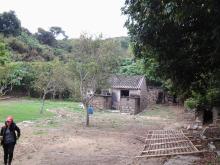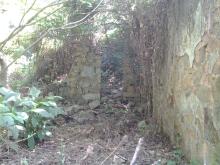I was shown how to get to this tunnel by our event host, Robert, who has lots of knowledge about Lamma Island, after a beach cleanup with the Hong Kong Hiking Meetup (https://www.meetup.com/hongkonghikingmeetup/events/238825314/) .
It is difficult to locate the tunnel on the map, so the coordinates shown may be a bit off.
To get there using Shek Pai Wan (which we cleaned) as a starting point, go south on the concrete footpath and turn right to get to Tung O village. (This path goes all the way to beautiful Sham Wan, where sea turtles lay eggs).
Somewhere along the way, you will see a banyan tree growing on top of a big piece of rock. Just before you get near this rock/tree, turn right (if I remember correctly), and you will see the view in the photo. Go behind the house and you will see some ruins. Go behind the ruins and the tunnel entrance is on your left.
Bats and other inhabitants are inside. They are harmless, according to Robert, so please don't harm or disturb them.



Comments
Thanks for adding the details
Thanks for adding the details of this tunnel. Was any information given about who dug it and when? Also curious to know about the layout - whether just a single tunnel & entrance, or multiple branches / entrances?
Regards, David
more info
I was told that the Japanese soldiers lived in Tung O Village to avoid being found by the Allies during WWII, and they dug this tunnel because of air raids by US bombers. If I remember correctly, it is "y" shaped, with 2 entrances and a dead end.
It is not too long - took us about 1 minute or less to reach the dead end, and it appeared hand-dug. You have to bend down a bit at the entrance. Inside it is about 2m high and 1.5m wide if I remember correctly.
The tunnel floor, walls and ceiling are not lined with cement or concrete. The exposed granite is slightly to moderately decomposed (you can scratch off grains of sand using, say, a coin, or even your fingernail in some places), making it unsafe to enter if there has been, or during, heavy rain. Near the entrance, tree root was seen penetrating into the tunnel from above.
Here is a link to photos of one/some of the caves on Lamma (not sure which one(s), as the author has not specified) https://www.facebook.com/arobert.lockyer/posts/10155924586102506?pnref=…
more pictures taken on 30 May 2017
I went there again on 30 May 2017 and took more pictures to show the surroundings of the cave, as well as the cave entrance itself.
Didn't enter the cave and left in a hurry as there were lots of mosquitos.
Dr Robert Lockyer is facing deportation from HK
Dr Robert Lockyer, besides being an environmentalist, knows a lot about the natural and human history of Lamma Island. I have explored many of the WWII Japanese tunnels on the island under his guide. It is sad to hear that he is currently facing deportation from HK. Use this link if you want to help http://chng.it/c9vQ4TqkCR